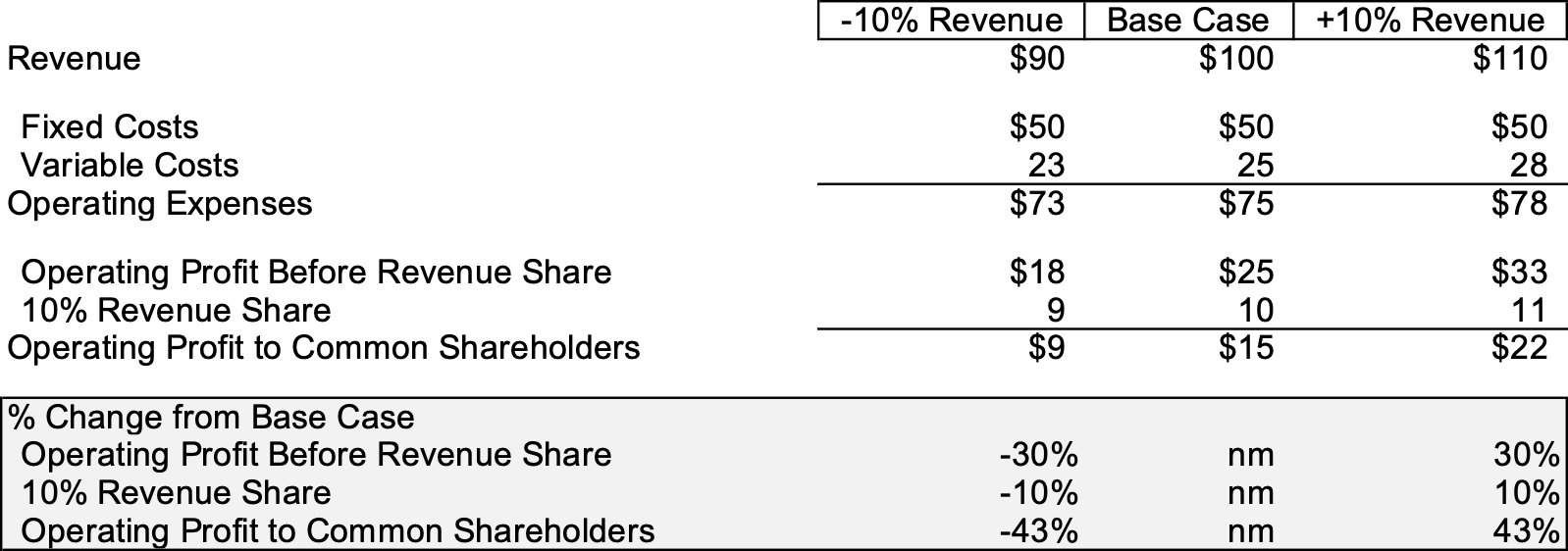Revenue Share Transactions: Considerations for RIAs
Minority interest transactions represent a way for RIA owners to monetize a portion of their firm without committing to the lifestyle changes often accompanying a sale to a control investor. A minority transaction can solve issues relating to succession, growth capital, and liquidity and can do so in a way that leaves the door open for a larger transaction later.
As outside capital for RIAs has become increasingly available, so too has the opportunity set for RIAs interested in pursuing minority transactions. One of the structures that’s emerged for minority transactions is that of the revenue share. In a revenue share transaction, the outside capital partner receives an ownership interest in the firm that is granted as a claim on a specified percentage of a firm’s revenue, as opposed to a more typical minority investment, which participates alongside other shareholders in the business’s profits.
Revenue Shares: A Minimally Invasive Partnership
Revenue share transactions can be an attractive option for sellers that desire a passive capital partner and minimal interference in the operations of the business post-transaction. Because the benefit stream flowing to the minority investor is a function of top-line revenue (rather than bottom-line profit), the buyer is largely agnostic to how the P&L is managed after the deal closes. This aspect alone can simplify post-transaction life enormously.
In addition, the structural protections of a revenue share mean that these transactions often include fewer governance rights and protective provisions relative to a typical minority interest transaction. For example, a revenue share investor is unlikely to have a board seat or say over how the firm manages things like compensation for key executives.
Economics of Revenue Share
A minority interest in an RIA structured as a revenue share can be equated to a “normal” ownership interest by expressing the minority investor’s revenue share claim as a percentage of the firm’s profits. Mathematically, this works out to be the same as dividing the revenue share percentage by the firm’s operating margin (e.g., a 10% revenue share on a firm with a 25% margin is “equivalent” to a 40% ownership interest).
However, this assessment of a revenue share comes with some important caveats. The math works over a single period, but over a longer time period, the firm’s margin is variable while the minority investor’s revenue share is constant. Thus, the equity-equivalent effective ownership of a revenue share changes as the firm’s profitability changes. In our example of a 10% revenue share on a firm with a 25% margin, the effective ownership of the revenue shareholder increases from 40% to 67% with 10 points of margin contraction; the flip side is that the effective ownership decreases to 29% with 10 points of margin expansion.

While a revenue share can be expressed as an ownership interest with equivalent dollar participation, those two interests have different risk profiles. The holder of a revenue share is exposed to the revenue stream of the firm and bears risk related to the factors that impact revenue: market movement, fee pressure, and client turnover. The holder of a normal ownership interest has an additional level of risk related to the firm’s operating leverage and factors that influence the profitability of the firm.
Creating a less-risky tranche of the firm’s capital structure doesn’t eliminate risk—it merely transfers it to the other classes of ownership. In the case of a revenue share, installing a less risky class of ownership tied to revenue results in amplified volatility for the common shareholders. In the example below, the firm’s cost structure is such that a 10% decline in revenue results in a 30% decline in operating profit. However, the benefits flowing to the revenue shareholder decline by only 10%, resulting in a 43% decline in profitability attributable to the remaining shareholders. The reverse is true in the upside.

None of this means that revenue shares are inherently a bad idea, but the increased risk that a revenue share creates for common shareholders is an important issue to consider when structuring a transaction. To work well, a revenue share needs to be compatible with other elements of your cost structure such that common shareholders can absorb the amplified volatility over a reasonable range of future outcomes. The lower risk profile of a revenue share relative to an ordinary ownership interest is also an important consideration when negotiating the pricing of a revenue share transaction.
A revenue share comes with tradeoffs, essentially giving an investor a preferred claim on the firm’s cashflows in exchange for retaining a greater level of control over operations. For many firms that value independence, the quality of life improvement afforded by a revenue share is worth this tradeoff, provided that the financial aspects of the transaction also make sense.
About Mercer Capital
We are a valuation firm that is organized according to industry specialization. Our Investment Management Team provides valuation, transaction, litigation, and consulting services to a client base consisting of asset managers, wealth managers, independent trust companies, broker-dealers, and alternative asset managers.
 RIA Valuation Insights
RIA Valuation Insights 






